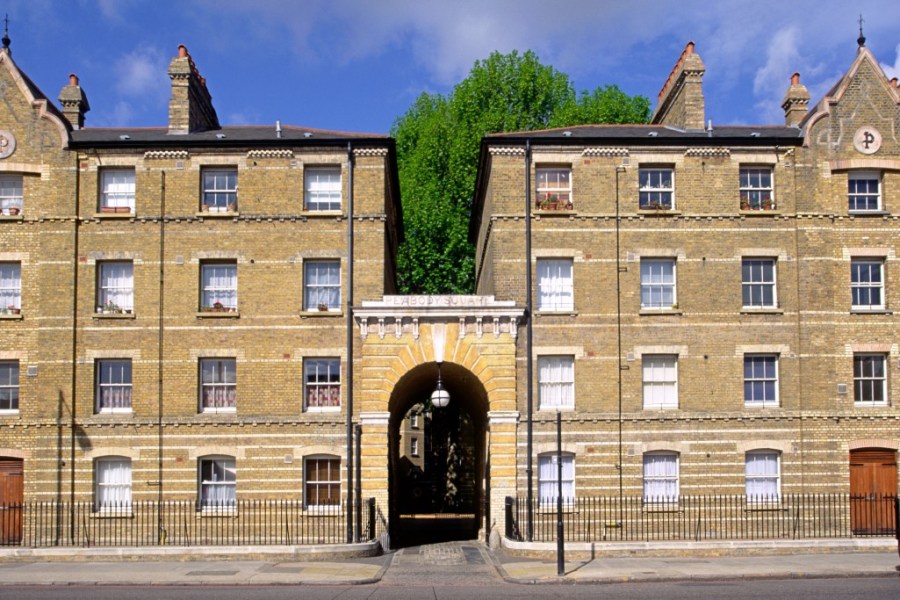‘Grim’, ‘gloomy’, ‘barrack-like’, ‘heavy, ponderous’ and ‘crushingly unattractive’ are typical of the adjectives evoked by the ubiquitous London architecture of the Peabody Trust, designed by the Victorian architect Henry Astley Darbishire (1825–99). Nikolaus Pevsner, in the volumes of the Buildings of England, could write of the ‘uncharitable look of the charitable architecture of 1860–80’. But there is no mistaking them: Darbishire created a distinct and recognisable style and type of building, of a decidedly urban character. More to the point, however unattractive they might seem, the estates he designed and laid out – in Islington and Southwark, Covent Garden and Pimlico, Whitechapel, Clerkenwell, and elsewhere – were so well built that they are still performing their intended function of housing Londoners of limited means. There must be a lesson in this, when so many of the council estates built at huge expense a century later have performed so badly that they have already been or are being demolished.
Darbishire is an intriguing figure about whom little is known. He must have showed sufficient promise for the likes of C.R. Cockerell and T.H. Wyatt to sign his RIBA Fellowship nomination papers in 1856. He also had a romantic side, for he was responsible for one of London’s most magnificent follies. This was the Columbia Market in Bethnal Green, a complex of Gothic Revival buildings with a great hall like the Sainte-Chapelle but with cast-iron columns, commissioned by the philanthropic heiress Baroness Burdett-Coutts so that East End traders could defy vested interests. It failed. When demolition was proposed in the 1950s, H.S. Goodhart-Rendel expressed wonder that Burdett-Coutts ‘should have entrusted the realisation of her noble dream to a practically unknown architect, who seems to have been incapable of producing a decent building of any kind’. This was unfair, for Darbishire also built Holly Village at Highgate for his noble and pious client. Here are, as Ian Nairn described them, ‘eight very spiky houses’, gothic again, arranged on a plan which ‘is as sensible and convenient as a London square with its central garden: a whole suburb could be built up of units like this.’
It was presumably because of Columbia Square, the blocks of social housing (also now gone) designed by Darbishire next to the Columbia Market, that he was employed by the Peabody Trust, founded and handsomely endowed by the banker and financier George Peabody (1795–1869) in 1862. This great and generous philanthropist was, in fact, an American. Self-made and Unitarian, he had fought when young against Britain in the War of 1812, but this did not stop him becoming Anglophile and he moved permanently to London in 1837. His trust was intended to benefit ‘the poor and needy of this great metropolis, and to promote their comfort and happiness’. The trustees eventually decided that this was best achieved through ‘the construction of such improved dwellings for the poor as may combine in the utmost possible degree the essentials of healthfulness, comfort, social enjoyment, and economy’. The first Peabody building, designed by Darbishire in an eclectic, vaguely gothic style, was opened in Spitalfields in 1864.
The Peabody Trust became the most successful and productive of the charities building ‘improved dwellings’ in London in Victoria’s reign but it was certainly not the first. The Society for Improving the Condition of the Labouring Classes had been founded in 1844, and was one of several responses provoked by the evangelical conscience to the housing problem in Britain’s expanding and industrialised cities. In 1849–50 the society built the block of Model Houses for Families which still stands in Streatham Street in Bloomsbury. Designed by Henry Roberts and consisting of five floors of self-contained flats accessed by galleries, it has rather more elegant external elevations than any of Darbishire’s buildings. Roberts went on to design the Model Cottages exhibited at the Great Exhibition and then re-erected in Kennington Park. These were intended as a sort of modular unit that could be expanded laterally and vertically to create blocks of basic, sanitary housing. Prince Albert took an interest in them.
Darbishire benefited from these precedents and, after initial experiments, produced the familiar Peabody architecture. His blocks were austere, minimally Italianate, with solid brick walls of yellow London stocks relieved by bands of hard white Suffolks and cornices and lintels of a tough terracotta. It was the aesthetic of the sublime rather than the beautiful. It is known that Darbishire was interested in structural polychromy and was influenced by some industrial architecture. Cleanliness, sanitation and ventilation were key concerns. The flats were certainly not comfortable by modern standards: internal walls were painted and not plastered; fixing wallpaper or even pictures to them was prohibited. And the estates were gated at night, with the tenants expected to maintain sober, austere standards. They were intended for the ‘respectable’ working class, for artisans. The poorest of the poor, those whom Charles Booth on his maps of London poverty described as ‘lower class – vicious, semi-criminal’, were not catered for.
Multistorey blocks of tenements existed in Edinburgh and in Continental cities, but not in London. The Peabody Trust and Darbishire brought something different to the capital. The estates were also innovative in terms of planning, for Darbishire placed his blocks around squares, presenting an austere brick face to the outside world. Furthermore, he planned all the estates with a standardised architecture, regardless of context and orientation of the site, until his retirement in 1885. As Irina Davidovici observed in an instructive analysis of Darbishire’s Peabody estates that was recently published in AA Files, ‘One can already perceive them as an early manifestation of modernism’s preoccupation with mass production and mass housing, rendered efficient through the serialisation of elements.’
No wonder they were compared to barracks. Charles Booth wrote in 1889 that ‘The first sentimental objection to the block life is the small scope it gives for individual freedom. The second is its painful ugliness and uninterestingness in external look…’ So, when it took on the problem of slum housing soon after its foundation in 1889, the new London County Council determined to build a more humane architecture, and the young architects in the Housing of the Working Class Branch, influenced by Philip Webb and the Arts and Crafts movement, designed new estates in a softer style that was not distinctively working class.
But Darbishire’s barracks had their merits. They were very well built (by William Cubitt & Co.) and have proved amenable to modernisation, so still they stand when so many of the modernist experiments in social housing have failed utterly. And, thanks to the trustees’ initial insistence that there should be a return of at least three per cent on all its investments, the Peabody Trust continued and today is the oldest and largest housing association in London, managing 27,000 homes housing 80,000 people. It is still building: for instance, a new estate is going up in Camberwell which faces across the Green from the cheerful façade of Peabody buildings designed in 1911 by Darbishire’s successor, Victor Wilkins. Long may George Peabody’s legacy continue to flourish: it is much needed these days.
Unlimited access from just $16 every 3 months
Subscribe to get unlimited and exclusive access to the top art stories, interviews and exhibition reviews.














![Masterpiece [Re]discovery 2022. Photo: Ben Fisher Photography, courtesy of Masterpiece London](http://www.apollo-magazine.com/wp-content/uploads/2022/07/MPL2022_4263.jpg)
It’s time for the government of London to return to its rightful home